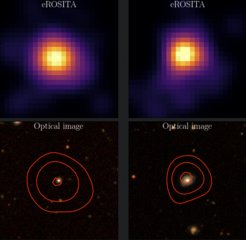Massive black holes in low-mass galaxies: what happened to the X-ray Corona?
Identifying massive black holes in low-mass galaxies is crucial for understanding black hole formation and growth over cosmic time but challenging due to their low accretion luminosities. Astronomers at MPE, led by Riccardo Arcodia, used the eROSITA X-ray telescope's all-sky survey to study massive black hole candidates selected based on variability in other wavelength ranges. Surprisingly, despite being flagged as accreting MBHs, the X-rays were weak and didn't match predictions from more massive AGN scaling relations. This discrepancy suggests either the absence of a canonical X-ray corona or the presence of unusual accretion modes and spectral energy distributions in these dwarf galaxy MBHs.

The centre of the Milky Way harbours a supermassive black hole – as do basically all galaxies of similar size and bigger than our Milky Way. But what about small galaxies? There is a hot debate in the astronomy community on whether all, or only some, low-mass galaxies are populated by “massive black holes”, anything between a few thousands to a few million solar masses. If these could be found and analysed, we could also learn something about the galaxies in the early Universe and how black holes grow over cosmic times, as the local dwarf galaxies closely resemble these first galaxies. So far, about 500 massive black holes have been found in the nearby Universe, as they need to be active and luminous enough to discern emission from their immediate vicinity from the host galaxy’s overall emission.
A team of astronomers has now used the all-sky survey with the eROSITA X-ray telescope to study massive black hole candidates selected by their variability in other wavelength ranges. “The variability at optical or infrared wavelengths indicates that there is some activity in the galactic nucleus. So, if there is a massive black hole accreting material, it should emit X-rays,” explains Riccardo Arcodia, who led the study at the Max Planck Institute for Extraterrestrial Physics (MPE) and is now working at the MIT Kavli Institute for Astrophysics and Space Research.
The only selection criterion for the sample was a cut on stellar mass to single out low-mass galaxies, leading to about 200 sources/MBHs. The team then looked for X-ray emission at the positions of these galaxies in the eROSITA all-sky survey and found only 17 sources, four of which had never been seen in X-rays before.
“The predicted X-ray luminosity of most of these candidates should be well above the detection limit of the eROSITA all-sky survey,” points out Andrea Merloni, eROSITA’s principal investigator. “Moreover, our stacking analysis of the non-detected sources shows that their emission is consistent with predictions for the X-ray emission of the galaxy alone.” While a possible X-ray weakness of massive black holes in dwarf galaxies was reported before for a few cases, this is the first confirmation on a large sample of homogeneous X-ray observations.

This means that the massive black holes in dwarf galaxies most likely behave differently than their supermassive counterparts. High-energy X-rays are typically produced in a region of hot plasma in the immediate vicinity of the black hole called the corona. In low-mass galaxies, the gravitational pull towards the centre is less strong and their interstellar medium is clumpier than in more massive ones, which might lead to differences in the magnetic field or the interplay between the accretion disk and the black hole corona. “This could be the reason why a classical corona was not found in these low-mass black holes”, says first author Riccardo Arcodia. “A different accretion mode in low-mass galaxies would also imply that selection techniques at different wavebands do not offer the same agreement seen at higher masses”, he adds. Future multi-wavelength studies on large samples are needed to test whether this is the case, or whether the X-ray emission alone is unusually low.
“This work serves as a pilot study for future synergies between eROSITA and VRO/LSST, which will perform a 10-year optical survey of the southern sky,” explains Mara Salvato, eROSITA Spokesperson and chair of the eROSITA followup working group. “We expect to find hundreds of LSST’s massive black hole candidates in eROSITA data, and hopefully learn a lot more about what is going on with the less-massive black holes at the centers of dwarf galaxies.”













